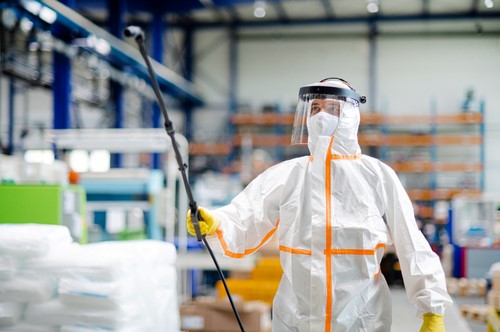

Home
SUPPLY CHAIN MARKETING More leads. More business. Build brand authority and your sales pipeline Grow your supply chain business with a tailored B2B marketing strategy designed by an agency of industry experts. Here's what we do Our services Let’s grow your...
7 skills logistics leaders will need to manage the digital supply chain
Digital supply chain management requires a whole new set of skills. From an omnichannel mindset to enterprise IT use, here’s what defines success of logistics leaders.
Editor’s note: This is the final guest post in a three-part series by Kate Began of Polycase.
It took some time for the tech revolution to hit the logistics industry, but now that it’s here, everything is changing rapidly. Suddenly, it’s all about omnichannel commerce, digital transparency, and advanced analytics (among many other trends). And as the world of logistics changes, the leaders of the logistics industry will have to develop new skills with which to navigate it.
What skills will the logistics leaders of tomorrow (and today) need to effectively manage the new realities of the supply chain? These seven areas will define the success of a business’s digital supply chain operations and separate the organizations that can fuel their success with technology from the ones who must struggle to adapt to it.
To manage the digital supply chain, here are 7 skills logistics leaders need
1. Ability to adapt
Twenty-first-century logistics will require its leaders and managers to constantly learn how to use new tools and react to changing market conditions. The new logistics professional has to keep a steady hand at the tiller during times of big change and use solid data analysis to find the right path forward, even when market conditions aren’t perfectly clear.
Flexibility will be incredibly important in implementing the most cutting-edge logistics technologies such as logistics blockchain, automation, and IoT. But it’s also critical to the daily operations of logistics when it comes to filling in transportation gaps and devising on-the-spot solutions to problems. The logistician who can harness the new digital tools for these ends will be formidable indeed.
2. Proactive curiosity
Adaptation is easier when a business pursues the right new tech, rather than waiting for it to come to them. Good logistics management will also increasingly require a commitment to proactively keeping up with technological and industry trends.
The 21st-century logistician has to be well-versed in everything from industry white papers to what’s trending among logistics professionals on LinkedIn. They need to be able to spot key trends and prepare for them so that businesses can stay ahead of the curve and not get blindsided by major changes.
3. Strategic thinking
Thinking two steps ahead can be tough when the business environment is changing so rapidly, but that’s what the new millennium logistics professional has to do. They have to take the long view and keep a business’s core principles at heart when creating plans for the future.
The need for strategic thinking also means tempering enthusiasm for new tech with good judgment and analytical rigor. Unwise investment in unproven or poorly-implemented technologies can be just as disastrous for a supply chain as lagging behind in tech, so as always, there’s no substitute for clear-eyed analysis and solid planning.
4. Enterprise IT use and procurement
Enterprise IT is an increasingly critical skill set for logistics professionals. Almost all logistics companies now use enterprise IT software, such as ERP suites, to manage their supply chains, and digital logistics professionals must often make decisions about procurement and implementation of these sophisticated software products.
Knowing how to get all of these disparate technologies to work together can be an even more difficult and necessary skill. Cross-platform performance can require knowledge of APIs and other tools that have been foreign to the logistics industry until now. Much of today’s logistics software is also cloud-based, so it’s also useful to know the basic principles of SaaS architecture and cloud workflows.
5. Project management
Today’s logistics professional often has to assume leadership roles on major projects. In order to be an effective leader, they must be skilled at tasks such as:
● Identifying the strengths and weaknesses of team members and delegating tasks to them effectively
● Working with upper management to structure project calendars and deadlines
● Estimating costs and planning for the budgeting and deployment of resources
● Identifying key technological tools for driving project success
● Creating transparency at all levels of the project by deploying appropriate digital tools such as IoT sensors and shipment tracking
Twenty-first century logistics concentrates more operational and computing power in every employee’s hand than ever before—but that power only produces results when employees are managed properly by a competent project manager.
6. People skills
Speaking of managing people, logistics professionals must also remember that not everything in the digital supply chain is run by circuits in a plastic enclosure. On the contrary, old-fashioned people skills are as necessary in the logistics industry as they’ve ever been—perhaps even more so.
Supply chains now have more stakeholders than ever, and effective management requires communicating effectively with a wide variety of personalities and roles. A good supply chain manager will be able to use 21st-century communication tools to connect people and make sure everyone’s on the same page, but they must also be fluent in the “soft skills” of empathy and interpersonal contact.
Empathy also requires a zero-tolerance mindset for regressive elements like sexism and racism in the digital workplace. Logistics may not be HR, but much of the everyday work of combating prejudice is done at the ground level by managers. For a business to attract and retain the best talent, they must pursue an egalitarian vision that makes work a great place to be for everyone.
7. An omnichannel mindset
Business, both B2C and B2B, now flows through a multitude of channels. That means that for the 21st-century logistics professional, an omnichannel mindset is a must-have. Whoever your customers are, they’re now on mobile phones, tablets and even voice command services like Alexa. A business’s platform and its logistics operations must reflect this new reality.
The rise of omnichannel commerce means that logistics operations must find a way to interlock with every channel that’s important to a business. That means keeping in mind how channels such as brick-and-mortar stores, traditional online sales and mobile shopping are all distinct but interrelated and managing them with an eye toward keeping every part of the complex interplay running smoothly.
There’s no running away from the oncoming wave of disruptive technology in the digital supply chain, so the only option is to ride it. Logistics professionals who are flexible, curious and empathetic will have the best capability for managing these new realities and turning them into a profitable and efficient future.
Kate Began serves as the Sales and Marketing Manager for Polycase. She oversees the customer service representatives, assists with product development, and leads the marketing efforts from the Avon, Ohio headquarters.
Read more:
When short on time, updating old blog posts for SEO makes a lot of sense
5 ways Covid-19 has already changed American manufacturing
Stop hibernating: You’re missing out on company blog benefits

5 ways Covid-19 has already changed American manufacturing
Editor’s note: This is the first in a series of three guest posts by Kate Began of Polycase.
The Covid-19 outbreak has changed the global business landscape in ways that would have seemed unbelievable just a few months ago. Businesses have been forced to reevaluate their approach to everything–from sourcing to operations. The manufacturing industry has seen particularly high levels of disruptions as plants are temporarily shut down and supply chains are disrupted.
A few months into the pandemic, trends have begun to emerge that allow the business community to begin to analyze Covid-19’s impact on American manufacturing. While supply has been constricted on everything from electronics enclosures to pharmaceuticals, demand has mutated in unpredictable ways, and businesses are scrambling to find new strategies for addressing these challenges.
These five aspects have already created major change in the manufacturing economy, and manufacturers will need to face them head-on to create a plan for surviving the continuing challenges of the post-pandemic business landscape.
1. Quarantines and shutdowns have caused some major hits to the bottom line for the American manufacturing industry.
Many U.S. manufacturers were forced to shut down as a result of the “stay-at-home” orders that their states imposed in March and April of 2020. Those that weren’t required to shut down often had to produce at reduced capacity, thanks to lower demand in many industries (as we’ll discuss later).
The result has been dramatic: an estimated 25 percent decrease in yearly profit predictions for the American manufacturing industry. While it’s true that manufacturers in some sectors, such as CPGs and medical equipment, have seen enormous spikes in demand, the overall financial picture for the manufacturing sector (particularly heavy industry) remains disturbing.
Having taken such a painful hit to the bottom line, many manufacturing businesses find themselves limping into Q3 and in need of a new plan for finishing out the year. Easy answers will be in short supply, but manufacturers will need to take decisive action to prevent a bad situation from becoming worse.
2. The devastating impact of lax safety procedures has become apparent.
American manufacturing businesses have to face the facts: During a pandemic, inaction is deadly. We’ve seen uncontrolled outbreaks sweep through meat-packing facilities across the nation, killing dozens and sickening thousands more. While it’s true that meat-packing plants are uniquely vulnerable to the spread of respiratory diseases, the risks apply to any facility in which workers are in close proximity to one another and/or share equipment.
Manufacturers owe it to their employees, their customers, and the world at large to ensure that their facilities don’t contribute to the spread of coronavirus. More than ever, practicing good workplace hygiene has become a matter of life and death. Businesses must be sure to follow the CDC’s guidelines for businesses and employers, and they must strictly enforce compliance among employees.
Steps as simple as requiring masks at work can significantly reduce the chances of disease spread. However, in order to truly reach the level of a responsible corporate citizen, manufacturers must commit to substantial reconfiguration of their processes to institute social distancing in the workplace.
3. Manufacturing supply chains have seen major disruptions.
The globe-crossing supply chains that characterize 21st-century commerce have had their reliability severely tested by the pandemic. China, in particular, has experienced major logistics problems, such as closed ports and grounded flights. With so many of the world’s manufacturing supply chains running through China, many businesses have had to find creative ways to keep their operations running.
Business experts say that this global supply chain chaos has been a major learning experience for manufacturers, who were often caught without sufficient options when their Chinese supply chains began to collapse in February and March. Going forward, these businesses will have to put a new focus on diversifying their supply chains to increase their resilience to globally disruptive events such as pandemics. Those low-priced Chinese components may do great things for the bottom line, but you can’t capture any of those benefits if you can’t get the materials in the first place.
4. Demand has plummeted in some sectors (and exploded in others).
With the Covid-19 pandemic has come an economic contraction that has suddenly plunged the U.S. economy into a recession. As a result, demand has massively decreased in many key American manufacturing sectors. Industry reports demonstrate that demand for everything from heavy equipment to electronics to metal fabrication continues to experience painfully intense contractions.
The silver lining for some manufacturers is that demand has actually increased rapidly in some sectors. Food, beverage, and other essential household CPG manufacturers have all seen massive surges in demand, as have medical supply manufacturers. The demand surge has even reached some unexpected corners such as the DIY home products industry as bored, homebound Americans take on home improvement projects.
These shifts in demand have produced some fascinating examples of the versatility and agility of leading American manufacturers. Top consumer fashion brands have begun production of surgical masks and gowns, while industrial manufacturers like 3M have used their state-of-the-art fabrication facilities to produce ventilators and other key healthcare equipment.
5. Cash flow will be a major priority moving forward.
In a turbulent economy, many manufacturers are reevaluating their cash flow strategies and prioritizing liquidity. By maintaining increased cash reserve levels, manufacturers can prepare themselves better to deal with the constantly shifting nature of the Covid-19 crisis.
Bolstering cash flow effectively requires applying a finance-driven mindset across all levels and departments of a manufacturing organization. The day-to-day practice of supply chain operations tends to be conceptually grounded in inventory management and customer relationships. While these are critical facets that can’t be sacrificed, supply chain operators need to become more practiced in thinking like a CFO and seeing the financial framework that underpins logistics decisions.
However, it’s important to remember that financial concerns should never take priority over the safety of employees and customers. The ultimate goal is to create a system of operations where both employment and physical well-being are safe and well-protected.
The novel coronavirus has given the U.S. economy a massive dose of that most dangerous economic toxin: uncertainty. For manufacturers to continue to thrive and compete, they must turn that uncertainty into innovation and seize the new opportunities that this rapidly changing economy presents to them.
Kate Began serves as the Sales and Marketing Manager for Polycase. She oversees the customer service representatives, assists with product development, and leads the marketing efforts from the Avon, Ohio headquarters. Kate is also an avid Cleveland Indians fan.
Read more:
Stop hibernating: You’re missing out on company blog benefits
When short on time, updating old blog posts for SEO makes a lot of sense
Key step to moving beyond survival mode: Revising B2B buyer personas

